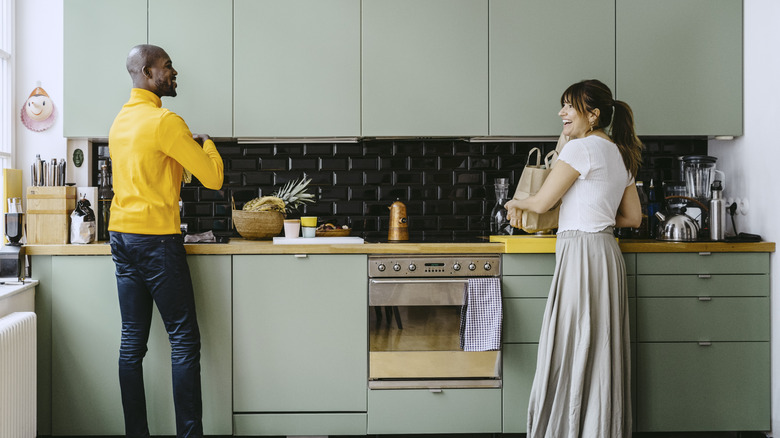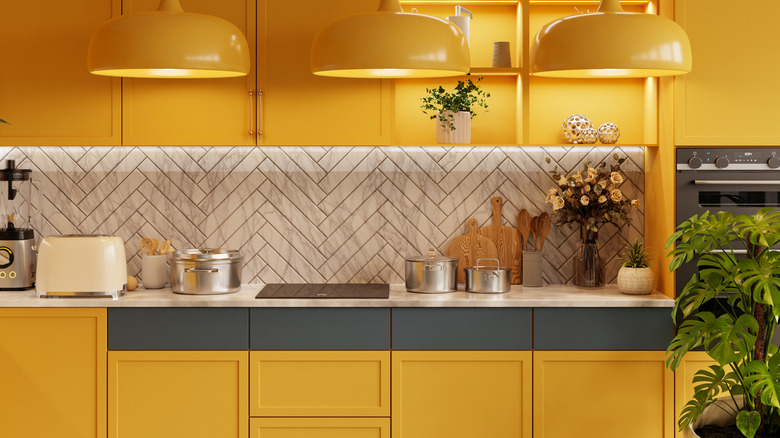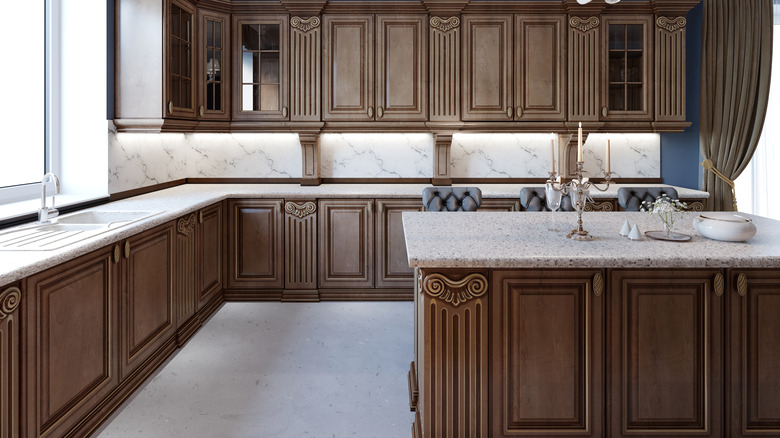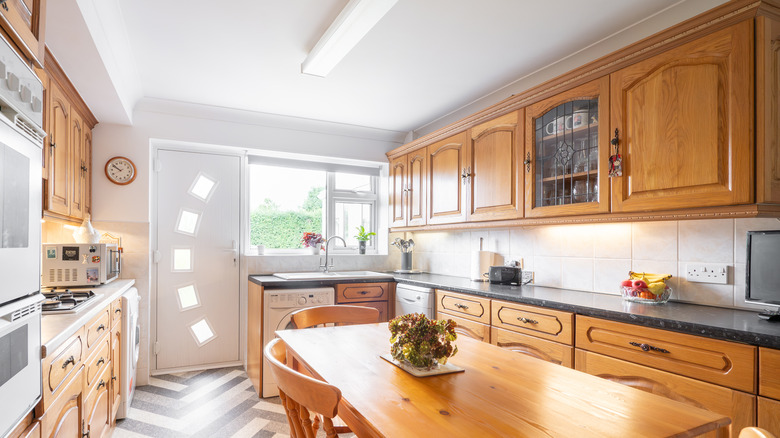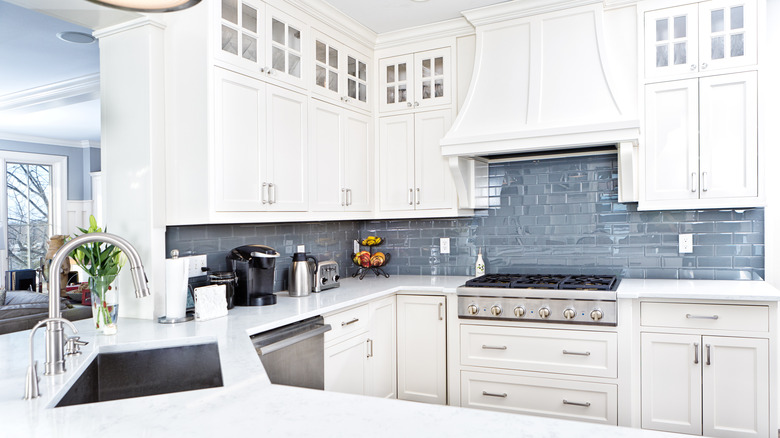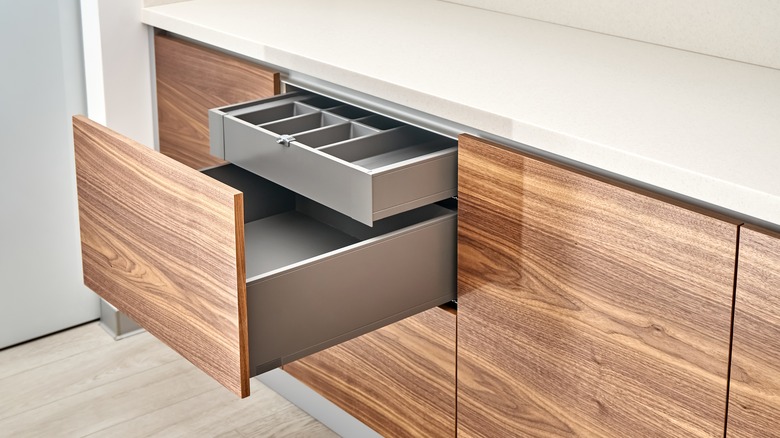Common Kitchen Cabinet Finishes And The Pros And Cons To Consider For Each
We may receive a commission on purchases made from links.
Cabinets occupy some of the best real estate in a kitchen — whether you're cooking, cleaning, or entertaining, you have to make an effort not to gaze at their doors and drawers. Thanks to their prominent location adjacent to sinks, cooking surfaces, and appliances, cabinets face the grueling task of resisting heat, vapor, water, grease stains, and all other manner of abuse. Over time, these stresses wear out the once-elegant surfaces, and your cabinets start looking drab. So, when it's time to freshen up your kitchen, choosing a new cabinet finish may naturally be at the top of your mind.
Fortunately, there is a wide assortment of kitchen cabinet finish options out there. Gone are the days when wood and appliance-matching paint were your go-to options. The modern selection of finishes caters to different aesthetic preferences, budgets, and durability expectations, and each finish comes with its benefits and drawbacks. Below, we've lined up five of the most common cabinet finishes, paint, stain, varnish, laminate, and veneer, to discuss their pros and cons.
Paint offers a palette of color options
Whether you're going for a minimalist white, luxurious black, or vibrant green, paint is your go-to finishing option if you want to give your cabinets a modern facelift. Paint itself is not the cheapest finish type, with professionals charging under $200 per cabinet door, including labor and materials. However, you can save by opting for inexpensive MDF cabinets vs. their pricier wooden counterparts; it makes no sense splurging on wood if you will conceal its natural aesthetic with paint anyway.
Paint offers a few other benefits in addition to the cost savings found in paint-grade door materials like MDF. If you're updating the cabinets as part of a kitchen remodeling project, a new coat of paint offers a great opportunity to redesign the kitchen aesthetic. While other finishes accentuate the look of wood and create a traditional look, painting affords far more color possibilities and a clean, contemporary feel.
On the other hand, a paint job only lasts about 10 years on most cabinets and is particularly prone to chipping over time. Paint's tendency to succumb to wear quickly means that you'll need to touch up the cabinets at some point in the future. This brings us to the other major drawback: touching up painted cabinets is often challenging since you may not be able to find paint with the original kitchen cabinet color. Finally, painting cabinets is not as easy of a DIY task as staining. Painting mistakes are generally more prominent because brushes leave smears on the surface, so it's a task best left to professional painters.
Stain brings out wood's natural beauty
If your kitchen cabinet doors and drawers are made of natural wood, staining them may be a more sensical alternative to painting. Stain is a type of translucent pigment that seeps into the wood fibers, somewhat altering their color while preserving the grain. While paint completely obscures the wood's visual characteristics, stain emphasizes them. So, where paint is a natural choice for a grain-less material like MDF, stain is a better alternative for cabinets made of oak, maple, cherry, alder, and other species with a prominent grain.
Another reason to choose stain is if you prefer rustic over a contemporary look. Paint gives the kitchen a sleek, modern feel, whereas stain invokes associations with bygone times. On a more practical note, stain is easier to work with if you're DIYing the cabinet upgrade. Unlike paint, stain does not require a primer coat since you're not trying to conceal the wood's visual features and imperfections. Once you've stained the cabinets, you can expect the new finish to last two to three decades without needing touch-ups. And if you do need to restain bits of the surface, you can use touch-up markers like the ones in this furniture repair set from DAIXISM.
However, staining kitchen cabinets isn't without downsides. For one, any imperfections in the wood will remain visible after you've applied the stain. Likewise, darker stain colors tend to show dust accumulation on the cabinet surfaces. Finally, whereas paint is easy enough to sand off if you want to refinish the cabinets in the future, removing the stain finish will prove more challenging since it penetrates deep into the wood pores.
All natural wood cabinets need is a clear protective coating
If you have natural wood cabinets and have no desire to alter their color, stain and paint are obviously out of the question. The cabinets already come with the aesthetic you like, and now all you need to do is protect them from the surrounding environment. Unfortunately, the kitchen environment is anything but friendly to wood cabinets. The stove emanates heat, which can stain the wood; cooking and washing activities create moisture, which can cause the wood to warp; finally, oil and food splatters can leave stubborn blemishes on the cabinets' surface. A clear, polyurethane varnish shields the wood from these horrors without concealing its innate beauty. It is the same type of product used to protect furniture and hardwood floors.
You can use one of two types of protective finishes on wood cabinet doors or drawers. The more economical, oil-based polyurethane varnish is a good option only if your wood is naturally dark or you're on a tight budget. The varnish is messier to work with, takes about 10 hours to dry and a month to cure, and emits toxic fumes before it's fully cured. Meanwhile, water-based polyurethane dries in just four hours, cures in three weeks, and has a less offensive odor. On the downside, water-based varnishes generally cost almost three times more than oil-based equivalents. Unless you're DIYing the finishes, these costs are often offset by the higher labor costs stemming from lengthier drying times between coats.
Laminate is an inexpensive and durable way to finish cabinets
Laminate is a thin sheet composed of paper and resin. This layer can be made to imitate a number of natural finishes, such as wood, and is generally adhered to an MDF core. You can purchase premade laminate cabinets or reface your existing MDF cabinetry by applying a sheet of newly purchased laminate to their surface.
If your MDF cabinets are due for an upgrade, laminating them makes for an appealing alternative to painting for several reasons. For starters, applying laminate is a less tedious task than painting if you plan to handle the project without professional assistance. While painting requires you to prime the cabinets, apply the paint, and let it dry, lamination is a far simpler task. Essentially, you adhere the new sheets, then adhere banding to the door edges. Laminate is also easy to keep clean; you only need a sponge and a basic household cleaner to wipe any smears off the surface. Finally, laminated cabinets are less prone to warping, staining, or scratching than those made from wood.
Laminate may not damage easily, but when it occasionally chips or cracks, you'll have no choice but to reface the cabinets since broken laminate sheets are generally irreparable. Another downside to laminate cabinets is their sensitivity to moisture and heat–environmental conditions present in any kitchen. If the cabinets are subjected to heat or hot vapors rising from the stove, poor-quality laminate can detach from the doors' cores.
Veneer offers the texture of real wood
Much like laminate, veneer is a type of decorative layer glued onto a manufactured cabinet core. Unlike laminate, veneer is made of thin sheets of real, lacquered wood and likely originated in ancient Egypt. Today, it tackles the same problem it solved millennia ago — it lets you use a very thin (and thus affordable) layer of a unique, expensive wood species on top of a cheaper core. You'll find veneers made from red oak, walnut, acacia, beech, and many other tree species. And while laminate can mimic the look of wood, veneer also imbues the cabinets with its texture.
Now, you may remember wood veneer furniture peeling and chipping away back at your childhood home. Rest assured that nowadays, such quality issues are generally a thing of the past. Wood veneer has evolved greatly in recent years, and the material is as durable and reliable as other, more modern cabinet finishes. In fact, wood veneer resists warping well — unlike solid wood, which can lose its shape after prolonged use in a hot, moist environment.
However, just like laminate, veneer can chip or crack if it isn't maintained well. Exposure to excessive light can also cause veneer cabinets to fade with time. Repairing these defects is virtually impossible since any touch-ups are unlikely to match the original color.
